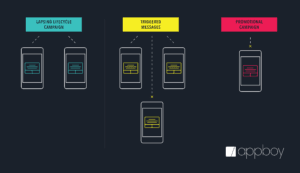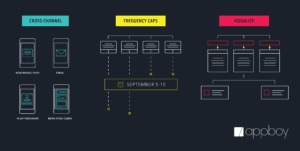How to Keep from Alienating Customers with Over-Communication
Published on June 14, 2017/Last edited on June 14, 2017/8 min read


Team Braze
Dear reader: This blog post made its original debut in Appboy’s Relate Magazine. Pocket its pearls of wisdom, and then for more information, check out our new Cross-Channel Engagement Difference Report!
Modern customer messaging can often feel like a balancing act.
Brands want to keep their outreach responsive and relevant, so they turn to triggered messaging to automatically send campaigns when users carry out particular actions—for instance, viewing a product page or consuming content on a given topic. But while triggered messaging is powerful, it’s a fundamentally reactive approach to customer communication. To effectively reach customers who aren’t taking the actions you’d like them to, you need to supplement those triggered messages with ongoing lifecycle campaigns.
But while both kinds of campaigns have a key role to play, using both types of messaging at the same time can lead to accidental over-messaging, hurting the effectiveness of your marketing efforts. That’s a big issue and it can have major consequences: 78% of consumers will turn off push notifications or uninstall if they’re unhappy with the messages they receive.
Imagine that someone downloads your app, but doesn’t actually open it until your “wait 3 days” push notification was planned, and then their actions in the app trigger a few more messages (once they complete several onboarding steps)… and all of this happens during your brand’s big annual sale. Suddenly, a user might have 10 emails or push notifications in a 2 hour window—which might feel like way too much, especially if they only recently signed up and are still getting to know your app.

When your team has put time and effort into developing targeted content and engagement strategies, the last thing you want is to turn off users by making them feel smothered. Even worse, this kind of overload also has the potential to drive away power users, the fans you want to make sure to keep—and monetize.
No one wants to intentionally bury users in messages. Luckily, there are some tools you can use to help ensure your campaigns delight instead of disappoint.
(The Good Kind of) Trigger Happy
Relevance is crucial for building relationships, and triggered messages help your communications land when your app is still top of mind. As a bonus, you can show that your system is responsive to what users are doing and offer tips or incentives. When a user takes a key action, such as signing up for your app or website, hitting a major usage milestone, or checking in at a location, you can verify the action was completed and give users guidance on the best next step.
What if they already took that next step? By appropriately delaying messages or adding exception events, you can avoid sending outreach in cases where the user has already completed the goal action, saving you from a very superfluous message. For example, waiting to send an abandoned cart reminder can give people enough time to complete a purchase but should still catch those drifting away before they forget (Not sure how long to wait? Consider testing a few different delays to see how they impact conversion rates.)
Triggered messages can cause overlap issues with other campaigns because there’s no way to know exactly when user actions might trigger automatic outreach. Also, over time, older triggered campaigns might sit in your system and end up being taken for granted. It’s important to set regular review periods to refresh and re-evaluate campaigns and keep track of them as you plan new ones. An outdated message delivered responsively is going to be more alienating than no messaging at all.
The Right Campaign for the Right Time
Customer journeys are becoming more complex—which requires marketers to become more creative and savvy about meeting their users’ needs. Every brand has its own unique audience, but members of that audience are generally going to fit into one of the four main stages of customer engagement: loyal, active, lapsing, or inactive.
Since the path between these different stages is far from linear, the best approach is to monitor your customers’ interactions with your brand (especially those that seem to lead to key conversions) and take steps that will help nudge people to become more engaged over time.
Campaigns focused on guiding customer journeys often target specific users in each of the groups with the goal of encouraging them to take a specific action. You might encourage your active users to join your app’s reward club because you’ve seen this lead to increased purchases, for instance. These campaigns could lead to overlap when users move from one category to another or if their conversions trigger additional messages. Be mindful of this potential for over-messaging when designing these campaigns and make sure you assess your existing campaigns before adding new outreach.
Give All the Channels a Chance
If you find you’re favoring a particular messaging channel, like email or push, that channel may well be the first channel to see over-messaging when campaigns intersect. A cross-channel approach can help you make the most of all your options without overloading.
Spreading messages between push (web and mobile), email, in-app messages and News Feed Cards can distribute your communications across channels and ensure the most important ones have a stronger chance to be seen. Plus, reaching users with the right type of message at the right time can be a great retention boost.
How do you pick the best channel for a particular message? There are a few factors to consider, such as urgency and the type of content. Push has the benefit of reaching users outside the app at a key time, but potentially the greatest risk for overuse. Email may not be as timely as push but it provides another touchpoint outside the app and can support longer, richer content.

News Feed cards may not have the same character space or urgency, but if well used, they can be highly- targeted and personalized based on user behavior and provide access to content streams to encourage deeper engagement. In-app messages can captivate users with rich content and can be sent in a variety of forms—but, like push or email, these messages also run the risk of annoying users if overused.
Reaching the Cut-off
Frequency capping is another great way to avoid over-sending messages during a specified period of time. You can set message caps to ensure users see no more than X number of messages (either overall or in a particular channel) during a single day or week—in line with what seems to work best for your users.
Messaging and other social apps can likely get away with sending multiple push per day but the same is probably not true for travel apps. You may also be able to identify when certain messages are important enough to override the cap, so you can set a general rule but still have the flexibility you need to ensure that essential messages are seen.
Visualize It
One of the best ways to fix over-messaging from the start is by having a system that lets you visualize active campaigns. A highly-visual customer lifecycle management tool like Appboy’s Canvas makes it possible to set up customer journeys to actually see all the campaigns your customers might encounter and test specific pathways of messages within a segment. (And because Canvas now features AI, it’s possible to orchestrate smarter customer communication and amplify every campaign’s accuracy.)
If you’re setting a lot of triggers and sending a lot of messages, it can be difficult to keep all of your active campaigns and their specific schedules and nuances straight in your head—so don’t try. Instead, map them out so you can see all of them together. You can integrate testing into the system and compare the performance of different pathways to inform your future campaigns. This approach is also helpful to get a better handle on messaging cadence and send times to see what gets a better response.
The Gist
Ignoring the positive impact that using triggered messaging and ongoing lifecycle campaigns together can bring is a big mistake—but so is leveraging these kinds of outreach without thinking through the implications of using them at the same time. To keep from overwhelming your customers, make the most of visualization tools and frequency caps to set up more balanced messaging cadences, embrace messaging testing and cross-channel outreach, and pay attention to negative KPIs like push notification opt-out rates.By embracing the complex nature of these relationships and keeping your users front of mind makes it possible to find the right level of communication for your brand.
Be Absolutely Engaging.™
Sign up for regular updates from Braze.
Related Content
View the Blog
How AI Decisioning Transforms Marketing (A Complete Guide)

Team Braze

AI decisioning cheat sheet: How to crawl/walk/run with BrazeAI Decisioning Studioᵀᴹ

Team Braze

A day in the life of a data scientist on the BrazeAIᵀᴹ forward-deployed engineering team
